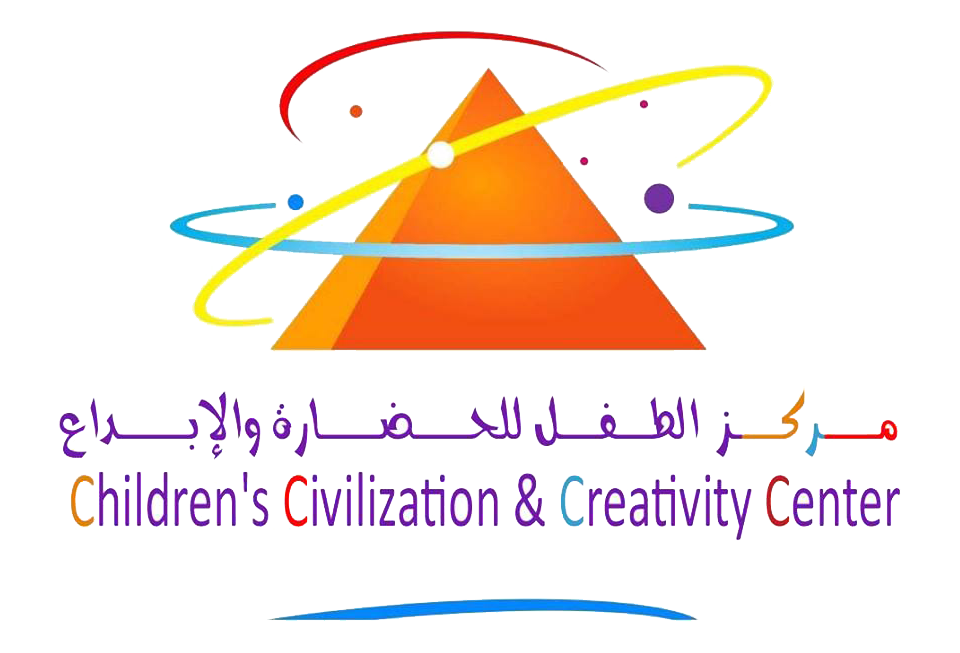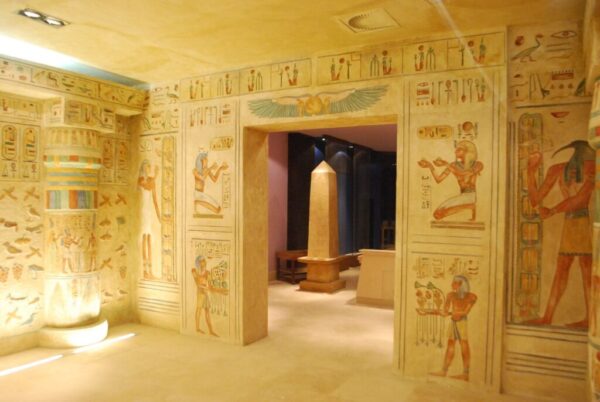Upon arriving at the basement, visitors feel immersed in ancient Egyptian civilization as if they are in a time machine as the construction of the pyramids begins, where the visitor watches a documentary about the construction of the pyramids presented by the Egyptian archaeologist “Dr. / Displaced Hawass.” After watching the film, the visitor walks through a tunnel similar to the “Khufu” Pyramid, the largest pyramid in Giza, during which he watches an introduction to a group of interesting documentaries about the secrets of the pyramids,
The engineers and pharaohs were the builders of the pyramids
Tourists also learn about the whereabouts of ancient pyramids and temples, and there are more than 120 pyramids in Egypt.
Visitors also learn about how the ancient Egyptians developed their pyramids, reinforcing their belief in life after death. Through interactive games, the visitor learns many secrets through the pyramid game, including the inner passages of the Great Pyramid. He also learns about the location of the most famous pyramids in Egypt through the magnetic map puzzle game, where he rearranges the puzzle pieces on the magnetic map of the locations of the most famous pyramids in Egypt.
Visitors learn about the ancient Egyptian art in the field of drawing through a group of interesting video games, interactive touch screens, and drawing tables. The ancient Egyptian civilization used drawing as a language of communication and writing, which is a small workshop for visitors
Through which the visitor gets acquainted with the ancient Egyptian arts in the field of drawing, where the ancient Egyptian civilization used drawing as a language of communication and writing, through a group of interesting electronic games and interactive screens. Touch screen and drawing table, which is a small workshop for visitors The visitor experiences the decoration of the walls of the pharaonic temples, which the ancient Egyptian knew since the beginning of the history of the ancient Egyptian civilization. With the experience of moving and rebuilding the “Abu Simbel” temple, as happened during the construction of Lake Nasser and the High Dam in Aswan in 1960, to avoid the sinking of the temple through a anthropomorphic puzzle game for the temple, the visitor also learns how the ancient Egyptians made clay pots and decorated them with beautiful drawings and inscriptions The ovens used at that time, as well as the science of ancient Pharaonic medicine in the treatment and herbal medicine and the tools used by the ancient Egyptians
And the statues and treasures it contains
In addition to a model of the famous mask of the king, in addition to watching a “hologram” documentary film about the discovery of the tomb by the English archaeologist (Howard Carter) in 1922.
It includes a replica of the mummy of King Tutankhamun. Through the x-ray machine game, the visitor can examine this mummy, identify its parts, and learn about the uses of modern science in revealing the details of ancient Egyptian civilization, in addition to learning about the organs of the human body through a model and a set of simplified educational panels.
It is identical to one of the archaeological sites in the Saqqara region
This allows the visitor to see the search for artifacts and methods of processing and restoring them
This area features a model submarine that allows the visitor to discover how the hydraulic arms used to lift submerged artifacts work. The area surrounding the submarine simulates life underwater through a huge electronic screen on which the visitor follows an interesting art exhibition while crossing to the ground floor.
On the ground floor there are three main rooms through which the visitor learns about the three seasons
It represents the nature of the life of the ancient Egyptians, which is
(flood season - planting season - harvest season)
And the activities carried out by the ancient Egyptians in every season
The ancient Egyptian divided the year into three seasons. The first season is the flood season. The ancient Egyptian believed that the Nile River came from Hapi Cave. The ancient Egyptian called the flood season the name Akhet. The tour begins on the ground floor in the section on “the flood season,” where the visitor watches a documentary film about the flood season among the Pharaohs, which is the period in which the waters of the Nile flood the land of Egypt, and how this season affected their lives, and how the ancient Egyptian calculated the Pharaonic year. Through astronomy. This role includes many interactive games, including
“Water Game” which explains to the visitor the impact of building dams on the surrounding environment and the methods of transporting water according to the ancient Egyptian farmer.
An interactive game about how the Lower Delta was formed
A game that teaches visitors how the ancient Egyptians built boats
The fishing game is an interactive game about the flood season. This part also includes the “House of Life,” which is the ancient Pharaonic school. Through it, the visitor learns about Pharaonic writing or “hieroglyphs.” The visitor sees a three-dimensional model of the Rosetta Stone, the key to solving the mystery of the ancient Egyptian language. The visitor also learns about the science of Mathematics and arithmetic among the ancient Egyptians
In this part, the visitor sees the extent of the ability of the ancient Egyptian to keep up with the requirements of life, as one of the goals was to transport In this part, the visitor sees the extent of the ability of ancient Egypt to meet the requirements of life, as one of the goals was to bring water to all lands, including the highlands, and to transport water From low to high plains. Where the ancient Egyptian used three tools:
(Saqia - Shadoof - Tanbour)
Prepared identically to those tools that were used in the past
The Nile has two sources: the Blue Nile, which comes from the Abyssinian Plateau in Ethiopia, and the White Nile, which comes from Lake Victoria. The White Nile and the Blue Nile meet in Khartoum, Sudan, and from there the Nile begins its journey until it empties into the Mediterranean Sea. The area has been equipped to give the visitor the feeling of being in front of the Nile River
The planting season comes after the flood season, which is the period that begins after the Nile waters recede from the land, during which the farmer can cultivate his land.
The tour begins in this part with the visitor watching a documentary film about the ancient Egyptian farmer’s methods of agriculture and the tools he used in agriculture.
Since construction among the Pharaohs was linked to the agricultural season, and through a group of three-dimensional puzzle games, the visitor learns about the art of Pharaonic architecture, construction methods and tools, and the shapes of Pharaonic houses. The visitor also, through the models, experiences building a Pharaonic temple for themselves.
The tour begins
Where the visitor watches a documentary film about the customs of the ancient Egyptians during the harvest season and the celebrations that follow the harvest, accompanied by the most famous musical instruments in Pharaonic Egypt. This part includes examples of ancient Pharaonic musical instruments.
This part is distinguished by the presence of the “market area.” With the harvest season, the markets are active and filled with crops. In this part, the visitor learns about the agricultural crops that were grown by the Pharaohs, as well as the methods of fermenting dough for making bread, and watches a film about the manufacture of chains and models of silos for preserving grains.
The visitor concludes his visit to the ground floor of the Pharaonic House, where he sees a model of a Pharaonic house and the furniture and Pharaonic ornaments it contains.
The ancient Egyptian used boats as a means of transportation on the Nile River. To make them, either papyrus stems or wood were used, and ropes were used to connect them together. There are many models of boats.”
Such as fishing boats - the royal boat - the goods transport boat - the military boats and the obelisk transport boat
In this area, the visitor learns about these boats through models identical to what was used by the ancient Egyptians
Another different journey with the contemporary Nile River begins by the visitor when he goes up to the first floor of the museum. He begins by watching a documentary film entitled “Children of the Nile,” through which the visitor learns about the customs of the children of the Nile Basin countries, the influence of the Nile on their environment and their connection to it, and watches a map of the Nile from source to mouth, and then the visitor continues. His first round trip to get to know the different regions of Egypt and learn how to preserve the environment and how to benefit from his country's resources
In it, the visitor learns about how to benefit from the dam to generate electricity, and learns about the importance of water in human life and how to preserve it and rationalize its use.
Through a group of interactive games, through which the visitor also learns how to preserve the environment in urban and rural life and how to preserve the Nile from pollution.
It is a group of educational games
The child learned how to preserve the environment in urban and rural life from pollution.
In it, the visitor sees a model of the chalk rock found in the White Desert
Through interactive games, the visitor learns about the effect of wind on the formation and shaping of sand dunes
Through it, the visitor learns about the types of fish and crustaceans
The coral reefs that this region is famous for and how to preserve them
During the journey from the first floor to the second floor
The visitor watches an interesting display of the planets of the solar system and the Earth
The tour begins in this floor by viewing models of the Temple of Dendera or the sanctuary of the goddess Hathor
It is considered one of the most wonderful and largest temples in Egypt. The temple is located in Minya Governorate on an area of 40 thousand square meters.
The importance of this temple lies in its use by the ancient Egyptians to study the astrological constellations
In it, the visitor sees a model of the telescope located in the Helwan Observatory, the oldest astronomical scientific institute in the Middle East and North Africa region and the second most manufactured telescope in the world.
The latest modern science equipment for studying astronomy and celestial bodies
By viewing this model, the visitor learns about its main components
The visitor watches three-dimensional films about celestial bodies and the planets of the solar system, in an exhibition hall designed in the latest style, with seating chairs designed in the colors of the planets of the solar system and in a new style that gives the visitor additional enjoyment while watching the films.







.jpg)
.jpg)
.jpg)
.jpg)
.jpg)
.jpg)
.jpg)
.jpg)
.jpg)
.jpg)
.jpg)
.jpg)
.jpg)
.jpg)
.jpg)
.jpg)
.jpg)
.jpg)
.jpg)
.jpg)
.jpg)
.jpg)
.jpg)
.jpg)